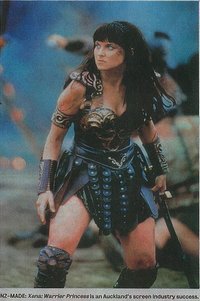 The New Zealand Herald has an interesting article on how Auckland is carving out it's niche as the country's screen capital. Very interesting and of course they use Lucy and Xena.
The New Zealand Herald has an interesting article on how Auckland is carving out it's niche as the country's screen capital. Very interesting and of course they use Lucy and Xena.
Scans by Jo.
NZ Herald 20 September 2010
Auckland carves out its niche as country’s screen capital
The Super City will build on the region’s role as the service centre for feature films shot throughout New Zealand, reports Graeme Hunt
No corruption of the Hollywood name exists to describe Auckland’s screen production industry — ‘‘Auckwood’’ does not quite have the panache of Bollywood or Wellywood — but Auckland producers are happy to let the region speak for itself.
About 70 per cent of the New Zealand screen production industry — anything from television, animation, advertising, feature films and documentaries — is based in Auckland, although crews work at locations throughout the country.
There are significant production and post-production facilities in the central city. Henderson and Rodney but, more importantly, most of the business of screen production, especially finance and deal-making, takes place in Auckland.
The region has a strong history of producing local dramas, television commercials, post-production and visual effects, as well as international TV and film projects.
Feature films shot in Auckland include The Chronicles of Narnia: The Lion, the Witch and the Wardrobe, The Chronicles of Narnia: Prince Caspian, 30 Days of Night, No. 2, Sione’s Wedding, The Bridge to Terabithia, Whale Rider ( indoor scenes), Once Were Warriors and The Piano.
The region has also hosted a number of international television series, many of which were filmed and postproduced in Auckland, including Hercules, Xena: Warrior Princess, Jack of All Trades, Power Rangers and Spartacus. One-o f f t e l e vi s i o n productions, such as Murder in Greenwich, Riverworld (filmed largely at Wenderholm Regional Park), Maiden Voyage and Lucy:The Lucille Ball Story, also have Auckland credits.
Regional development agency AucklandPlus, soon to disappear under the Super City reorganisation, has had the screen production in industry in its sights for some years.
It co-ordinated New Zealand Trade & Enterprise’s Screen Production Major Regional Initiative established in 2004 to increase the number of projects undertaken by the industry and secure jobs for the specialised teams involved.
NZTE contributed $ 2m t o t he initiative to help build the infrastructure needed to attract more work.
A world-class 2000sq m sound stage — the largest in New Zealand — was completed at Henderson Valley Studios in 2007 to help the region attract more international productions. The project attracted significant private investment and was managed by Waitakere Properties, a council-controlled organisation. Prime West was formed to own the $7m studio and run the sound stage as a commercial operation.
The NZTE funding was also used to launch a regional marketing campaign and a funding campaign to lift the i ndustry’ s c a pabi l i t i e s . These functions have been managed by Film Auckland, an industry-led incorporated society formed in 2003. Film Auckland’s objective is to create what it describes as a ‘‘seamless production experience throughout the region’’.
Generally local government has been helpful to production companies with Auckland City Council adopting a film protocol to keep the screen production industry on side (Local Government New Zealand has granted the region ‘‘film-friendly’’ status). The protocol, likely to be embraced by the new Auckland Council, contains details about process, timelines and costs associated with obtaining consent to film.
Auckland’s advantages include having a network of film industry professionals, great locations, quality postproduction skills and facilities, animation and visual effects skills, and reliable suppliers.
The low New Zealand dollar also helps as does the English language. Producers can also film in Auckland during the northern hemisphere winter.
The economic benefits seem to be matching the screen producers’ and promoters’ lofty aims.
In Auckland city alone, the screen production industry generated gross output of $343m in 2007, and GDP of $377m — a contribution exceeding that of the electricity, gas, and water sector.
Since then the screen production industry’s gross revenue has grown steadily. Nationally this was more than $2.8bn in 2009, nearly 2.6 per cent up on 2008.
South Pacific Pictures chief executive John Barnett said the screen production industry had proved itself recession proof.
‘‘We are finding a shortage of people right now.’’
The industry’s confidence has been in part been brought about by the success of local made-for-TV series like Shortland Street, Outrageous Fortune and Go Girls.
Screen Leadership Group chairman Tim Hansen, line producer with South Pacific Pictures, said the screen production industry would prosper under the Super City.
‘‘The advent of the Super City can contribute to this positively if the approach of the previously disparate bodies can be brought together under the new Teed structure. Waitakere Enterprise, Auckland City Council and AucklandPlus have all made impressive efforts over recent times to facilitate and encourage growth in this sector,’’ he says.
‘‘This has been ably partnered by Film Auckland and Michael Brook. It is important that the measures that these individual organisations and the councils they have worked for are not lost in the transition.
Hansen said the extent to which Shortland Street provided a feeder of skilled crew and cast for the larger international productions and to the local commercial sector had to be recognised.
It's the large i nternational productions which will inevitably provide the large cash input to our local economy, and that benefit should not be lost, but I fear it often is.
‘‘ Without the starting point of healthy and vibrant local production including local drama and commercial production, we will not provide the highly skilled practitioners biggerbudget international films need.’’
